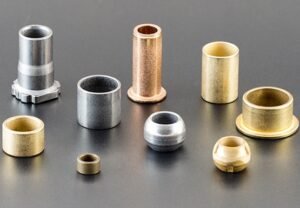
The Brinell hardness of sintered bronze is usually between 60 and 90, while the Brinell hardness of sintered iron can usually reach 100 to 120. Sintered stainless steel largely depends on the specific type of stainless steel, but usually it can achieve a Brinell hardness level of up to 200 to 350 and a Rockwell hardness level of up to 50 to 55 HRC.
Hardness is a measure of a material’s resistance to local deformation, which is usually caused by indentations or scratches. The hardness of metals is usually measured using a Brinell or Rockwell hardness tester. The hardness of sintered metal can vary widely depending on the specific material and sintering process used.
Sintered Bronze: The hardness of sintered bronze varies depending on its elemental composition and sintering process, with a Brinell hardness (BHN) generally ranging from 60 to 90. Sintered bronze is mainly used for producing mechanical transmission components such as self-lubricating bearings and gears. Bronze has excellent wear resistance and high-temperature performance, making it particularly suitable for bearings in high-speed, heavy-duty, high-temperature, and extreme environments. For example, bronze bearings are used in important components such as automotive engines’ connecting rod bearing shells, the bearing bushes at the end of machine tool spindles, the gears of motorcycle clutches, and the turbine discs of aircraft engines. Sintered bronze also has good corrosion resistance, making it widely used in marine engineering, chemical equipment, and various valves, water pumps, etc. in corrosive environments.
Sintered Iron: It can usually reach a hardness level of 100-120 on the Brinell hardness scale, which makes it very suitable for components that must withstand high stress and wear. It is usually used to manufacture various mechanical parts, especially those that need to be manufactured through powder metallurgy, such as connecting rod bearings, sliding bearings, gears, hydraulic parts, etc. in automotive engines. These parts typically require good wear resistance and may need to withstand significant loads in some cases.
Sintered Stainless Steel: It largely depends on the specific type of stainless steel, but usually it can achieve a Brinell hardness level of up to 200-350 and a Rockwell hardness level of up to 50-55 HRC. Due to its hardness and corrosion resistance, sintered stainless steel is often used in demanding applications such as the production of surgical tools and high-performance engine parts.

In summary, the hardness of sintered metals is a key characteristic that determines their suitability for different applications. Sintered bronze, iron, and stainless steel all have different hardness levels, suitable for various applications; Whether it’s machine parts, engine components, or surgical tools, each of these sintered metals plays a role.
However, hardness is not the only criterion for measuring the performance of sintered metals, and other performance indicators such as toughness, wear resistance, tensile strength, fatigue resistance, corrosion protection, etc. are equally important. According to different application requirements, it may be necessary to choose different sintered metal materials.

